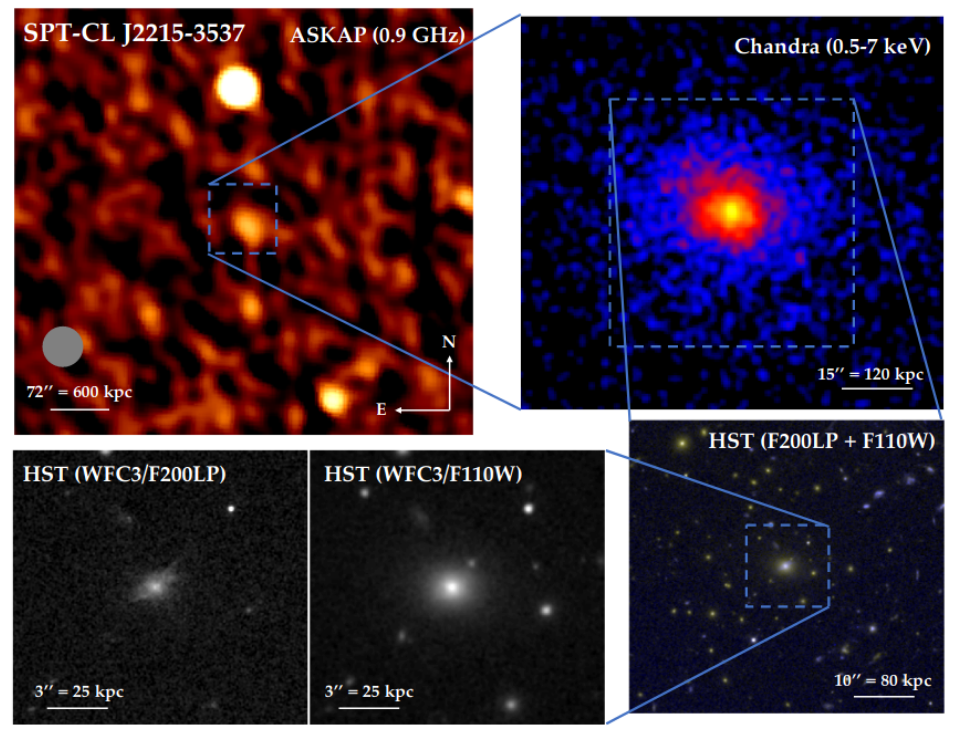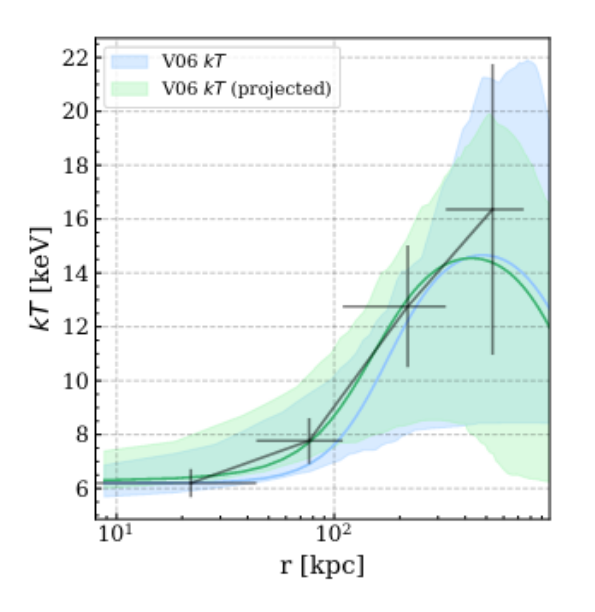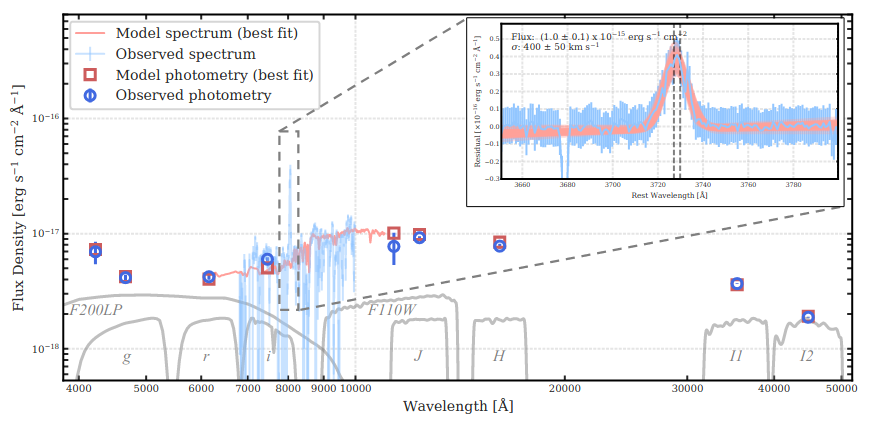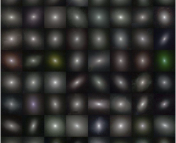Title: SPT-CL J2215-3537: A Massive Starburst at the Center of the Most Distant Relaxed Galaxy Cluster
Authors: Michael S. Calzadilla, Lindsey E. Bleem, Michael McDonald, Michael D. Gladders, Adam B. Mantz, Steven W. Allen, Matthew B. Bayliss, Anna-Christina Eilers, Benjamin Floyd, Julie Hlavacek-Larrondo, Gourav Khullar, Keunho J. Kim, Guillaume Mahler, Keren Sharon, Taweewat Somboonpanyakul, Brian Stalder, Antony A. Stark
First Author’s Institution: Kavli Institute for Astrophysics and Space Research, Massachusetts Institute of Technology, Cambridge, MA USA
Status: Accepted to ApJ [open access]
The largest gravitationally-bound structures in the universe are galaxy clusters – hundreds to thousands of individual galaxies, bound together by gravity and surrounded by dark matter and gas. Lurking at the center of these galaxy clusters are the brightest galaxies in the universe: the aptly-named Brightest Cluster Galaxies (BCGs).
Because BCGs are right at the center of their galaxy cluster’s gravitational field, the clusters themselves act like a well, funneling new material onto the BCGs. This means that BCGs grow very large, and that the evolution of the BCG is intimately linked to the evolution of the full galaxy cluster. Traditionally, it has been thought that the clusters feed the BCG with other galaxies full of pre-made stars (this mechanism is referred to as, no joke, galactic cannibalism – here’s a video on the topic). However, many BCGs have been observed to actively grow new stars. In these cases, it seems like the cluster is feeding free-floating gas known as Intracluster Medium (ICM) to the BCG. This ICM contains the ingredients for star formation (mostly hydrogen gas), and the BCG can process these ingredients into new stars itself.
Going with the Flow
In order for this second type of BCG growth to be happening, the galaxy cluster needs to obey some fairly specific criteria. There needs to be one specific BCG in the cluster, and it needs to be sitting at the center of the cluster’s gravitational field, in order to direct the ICM onto the BCG. The cluster itself also needs to be large enough to have a lot of concentrated ICM, and old enough that a lot of the initial heat (kinetic energy) in the ICM has had time to escape (if not, it will be moving around too fast to get caught by the BCG’s gravity). These types of clusters are known as ‘cool-core’ clusters, and the flow of ICM onto the BCG is known as a ‘cooling flow’. All of these things typically happen naturally in clusters, but they all require time, so they’re far more common in much older clusters at times much closer to the present day. These clusters are called ‘relaxed.’ That’s what makes today’s paper so exciting – the authors of this paper have found a relaxed cluster funneling material onto its BCG at redshift 1.16 (only about 5.3 billion years after the big bang). This is the earliest example of such a cluster found to date – this cluster must have relaxed faster than previously thought possible.

The Picture(s) of Relaxation
This cluster, known as SPT-CL J2215-3537, or SPT2215, was originally found using the Sunyaev-Zeldovich effect in a South Pole Telescope survey. Optical and UV imaging (Figure 1) from the Hubble Space Telescope and the Magellan Telescopes were used to find the galaxies associated with the cluster, and optical spectroscopy from Magellan was used to make sure that the galaxies were all associated with the cluster in all three dimensions. This optical spectroscopy also measured the distance to the cluster, using redshifting of spectral lines, and therefore confirmed that we’re observing this cluster earlier in the universe’s history than any other cluster of its kind. A faint radio-wavelength source (probably an Active Galactic Nucleus, or AGN) was also found to be associated with the cluster using the ASKAP array (Figure 1).
A Cool Customer

The ICM is very diffuse, and it isn’t typically visible in optical or UV measurements. In order to measure this cluster’s ICM properties, the authors had to take observations using the Chandra X-ray observatory. From this, they noticed that the ICM is distributed extremely regularly in the cluster, and that the ICM’s luminosity peaks very strongly in the center. As mentioned above, both of these characteristics are good indicators that the cluster is relaxed. The authors also measured the spectrum of the X-rays in order to determine the temperature of the ICM. By measuring different X-ray spectra at different distances from the center of the cluster, the authors developed a temperature profile (Figure 2). This showed that the ICM in the middle of the cluster in particular had a very low temperature, making it a cool-core cluster. Filaments of gas are also visible surrounding the BCG in the UV imaging from HST, suggesting that ICM is indeed falling onto the BCG.
Relaxed, but Working Hard
Finally, the authors measured a Spectral Energy Distribution (SED) of the BCG itself. This is a technique where the amount of light emitted from a galaxy is measured at as many different wavelengths as possible, and then the luminosity at these different wavelengths is compared. Different components of a galaxy (such as new stars, old stars, or gas) emit light at different wavelengths, so scientists can estimate how fast a galaxy forms stars by fitting measurements to models of these different components. In this case, the authors used the HST and Magellan measurements mentioned above (at optical and UV wavelengths), additional near-infrared Magellan measurements, and far-infrared (very long-wavelength) Spitzer Space Telescope observations to construct their SED. From the SED, they determined that the BCG in this cluster was forming 320 solar masses worth of new stars every year (about 300x the Milky Way’s rate)!

All of this evidence seems to point to a BCG forming stars out of fuel from the cluster itself. If this is the case, this will be the earliest-ever example of such a cluster, and it has some pretty exciting implications. The authors suggest that clusters relaxing this quickly may have a totally separate mechanism for BCG formation, independent from the cannibalism-driven growth we expect. It also implies that AGN (such as the one seen in the ASKAP imaging of this cluster in Figure 1) could start powering on earlier than expected, feeding energy back into the BCG and the cluster and disrupting star formation. The authors are working with more X-ray observations to characterize the physics of this cluster more precisely, and hopefully figure out some of the specifics of these implications.
Astrobite edited by William Lamb
Featured image credit: Galaxy Optical: National Optical Astronomy Observatory/Kitt Peak, Galaxy X-ray: NASA/Chandra X-ray Center/IoA




